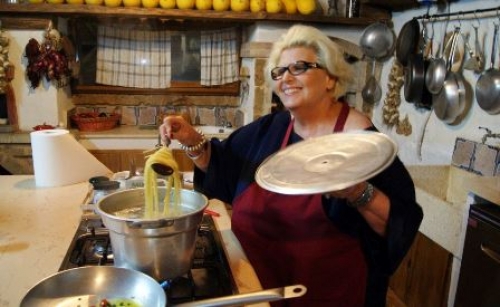Two of my Italian acquaintances recently tried to convince me that Italian-American food is not really Italian. Raised in an Italian-American family, this argument caused me to consider carefully the food we prepared and ate at home and the dishes I have tried in restaurants.
First we must consider where Italian-Americans learned to cook. If you were fortunate enough to have a nonna, you enjoyed days in her fragrant kitchen, sampling the dishes she spent hours preparing. From the time you entered the kitchen, food was most likely offered with a simple "mangia."
Some of us learned from mothers or aunts, watching and helping with the preparation. I can remember all the apron-clad women in the kitchen preparing meals throughout my childhood. I thought the lasagna, sausage and peppers and eggplant Parmesan were as common in every Italian household as meatballs! So I was surprised to hear that many Italian American foods are not found in Italy.
My friend, Monica lived in England for 12 years and has been teaching Italian and English for 20 years. She runs a B&B on the Riviera del Brenta, she loves food and she runs a food tour of Venice and its "osterie" (Venice tapas bars). Her passion is to show people who are not cooking experts that anyone can make some simple, delicious Italian dishes. You don't even have to have the greatest knowledge about food.
Here are some real eye-openers that she shared with me:
- Spaghetti and meatballs: This is not an Italian recipe at all. The origin of this recipe is very, very American. It seems it was the result of the creativity of Italian women who have emigrated to the U.S. in the early 1900's and who came from very poor backgrounds. The American tomatoes, needed to prepare the classic sauce, were very watery, so the women needed to add tomato concentrate as well as herbs, to flavor the sauce. Meatballs were simply added to the sauce because meat was abundant in America; in Italy at that time, meat was a luxury. Who knew?
- Americans have created the so-called "piatto unico," or a dish containing all food groups (meat, starch, vegetables). This does not exist in Italy.
- If you fry real fresh fish, there is no need for salt or lemon, as Americans often use.
- Italians simply grill steak on a dry grill, then sprinkle a couple of drops of olive oil on it and a pinch salt and pepper. There are no heavy sauces, marinades or seasonings.
For more of Monica's food facts, visit This email address is being protected from spambots. You need JavaScript enabled to view it..
An Italian foodie, Eva Sandoval wrote a detailed story for "Fodor's Travel" listing a number of foods that you won't find in Italy. I found several items that I had not considered:
- Garlic bread: Most of the time bread is not part of your meal; and if so, it is never served with butter.
- Italian Dressing: Salad is eaten after the main course and often only with a sprinkling of olive oil. Of course Italian olive oil offers the perfect complement to many foods. I sat down for pizza with the owner of a small hotel in Lake Garda and watched her pour oil over our hot pizza!
- Pepperoni Pizza: Pizza is sold by the square slice or as an individual round pizza for one person; you will never see a large pie shared at the table. Italians use an assortment of toppings, but in more than 20 years of annual trips to Italy, I have never found pepperoni.
- Lobster Fra Diavolo and Shrimp Scampi: These wonderful seafood pasta dishes are American. Seafood is an ingredient served only in areas of Italy near the sea. (My friend Monica tells me fish is cooked quickly, and if the fish is very fresh, it is eaten raw.)
So enjoy your "Italian" meals, and remember, sometimes what happens in Italy stays in Italy.



